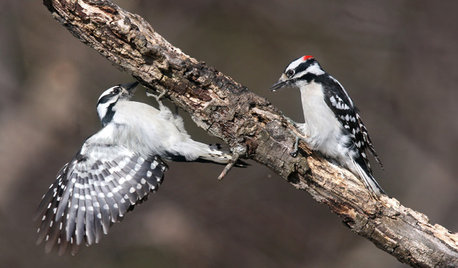Can you identify these tomatoes?
amunk01
10 years ago
Related Stories

GARDENING FOR BIRDSBackyard Birds: How to Identify Two Common Woodpeckers
Downy and hairy woodpeckers have similar coloration and behavior. But there are two big differences that separate them
Full Story
COLOR10 Reasons to Make a Splash With Tomato Red
You won’t duck at these tomatoes. See how bold red shades can play up architecture, light up a dark spot and add drama
Full Story
EDIBLE GARDENSSummer Crops: How to Grow Tomatoes
Plant tomato seedlings in spring for one of the best tastes of summer, fresh from your backyard
Full Story
LIFEKitchen Traditions: Tomato Season Meets a Family Legacy
Somewhere a Sicilian great-great-grandmother is smiling at a bowl of American-made sauce
Full Story
ARCHITECTUREHouzz Tour: Fresh Ideas in a Former Tomato Packing Shed
A formerly metal-clad structure is now a beautiful wood home designed to capture the light and preserve open space
Full Story
HOUZZ TOURSWe Can Dream: An Expansive Tennessee Farmhouse on 750 Acres
Wood painstakingly reclaimed from old barns helps an 1800s farmhouse retain its history
Full Story
GARDENING GUIDES4 Ways Gardens Can Go Beyond Aesthetic Beauty
Our landscapes can play an even more meaningful role if we rethink their purpose
Full Story
COLOR8 Color Palettes You Can't Get Wrong
Can't decide on a color scheme? Choose one of these foolproof palettes for a room that feels both timeless and fresh
Full Story
LIFEHow Your Landscaping Can Keep Burglars Away
Prevent home break-ins with strategic landscaping and good practices instead of menacing — and maybe less effective — measures
Full Story
LANDSCAPE DESIGNHow Low Can Hedges Go? Discover Unusual Garden Borders
Short enough to step over, high enough to be a stretch ... check out these radically different hedge styles and tell us your opinion
Full StorySponsored
More Discussions







Erod1
ScottOkieman
Related Professionals
Kaysville Landscape Contractors · Lake Saint Louis Landscape Contractors · Las Vegas Landscape Contractors · Milford Landscape Contractors · South Portland Landscape Contractors · Markham Landscape Contractors · San Pablo Landscape Contractors · Boone Decks, Patios & Outdoor Enclosures · Fort Pierce Decks, Patios & Outdoor Enclosures · Jupiter Decks, Patios & Outdoor Enclosures · New York City Decks, Patios & Outdoor Enclosures · Portland Decks, Patios & Outdoor Enclosures · Puyallup Decks, Patios & Outdoor Enclosures · Racine Decks, Patios & Outdoor Enclosures · Somerville Decks, Patios & Outdoor Enclosuresslowpoke_gardener
Okiedawn OK Zone 7
amunk01Original Author
amunk01Original Author
Okiedawn OK Zone 7